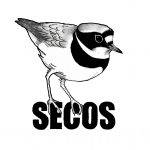Quakers Coppice is an area of mature woodland of about 4.5 hectares, on the edge of the Crewe Gates Farm Industrial Estate, at map ref SJ724545. The Coppice is owned by Cheshire East Council but managed by ANSA Environmental Services.
Nest boxes were first provided at Quakers Coppice in 1985 by Cheshire Wildlife Trust, who managed the area at that time. The Wildlife Trust put up boxes numbered 1 to 16. The management and monitoring of the nest boxes was taken over by Colin Lythgoe and Bryan Perkins. Additional small-hole boxes were provided by Colin in 1988 and 1991.
Several large-hole boxes specifically for Stock Doves were provided in 1991. These were monitored in detail from April to September each year from 1991 to 2001, providing comprehensive data for this period. Juveniles were ringed in the nest each year but there were no recoveries.
When Colin first visited the area in the early 1980’s there were no paths, ground vegetation was mainly dense brambles and it was difficult to walk in the wood. In 2010/11 the area had a surfaced pathway laid through the site and a pond dipping platform installed. The site is regularly used by pedestrians and is heavily used by dog walkers. While the site has many mature trees, there is now limited ground cover for ground nesting or ground feeding wildlife.
When one considers the now heavy usage of Quakers Coppice by dog walkers and the now limited ground vegetation, the following extract from a 1985 Cheshire Wildlife Trust leaflet shows how things have changed: “The reserve is closed during the main nesting season March to June inclusive. Damage and disturbance to birds and other wildlife is minimised at other times of the year if visitors would please keep to the paths. Please note that dogs are not allowed on the reserve.”
As of 2011 there are 38 boxes in place, 20 are “small hole” tit boxes, 3 are “tree creeper” boxes, and 15 are “large hole” or “chimney” type boxes, usually used by Stock Doves. SECOS members have continued to monitor use of the boxes through the nesting seasons – usually April to June, and to produce annual reports summarising the outcome.
As a result of the regular nest box monitoring since 1985, the records allow us to review variations in breeding data gathered over a significant number of years.
The annual reports from 2009 are now available to download in PDF format below.
